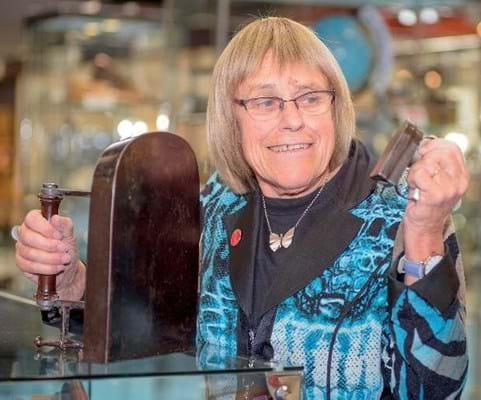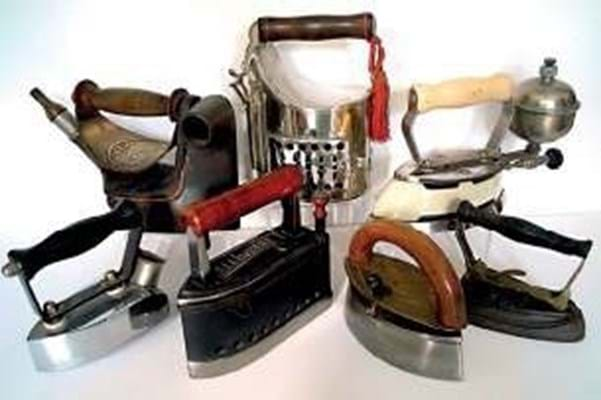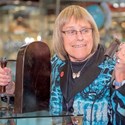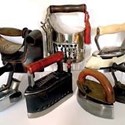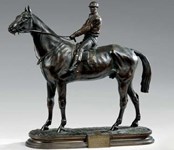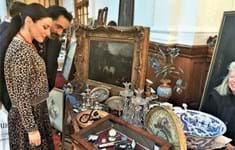ATG: What kind of irons do you own?
Penny Savill: With my husband, Harry, I collect laundry irons across the board. Everything from tiny lace irons to heavy, commercial tailors’ irons; glass slickenstones (used cold) to 20th century electric irons; solid cast flat irons to intricate crimping machines.
ATG: When did you start collecting?
In 1980, I moved into the house in which I still live and found a heavy old iron in the attic. Then we found some irons in a nearby farm that ran a second-hand furniture business.
We had to push of the hens and wipe away some muck and feathers, but we took a couple of irons home and when one became three of a kind, a collection was born.
ATG: How did you broaden your knowledge of your collecting area?
Keen to learn more, I went to an exhibition of irons at Bath University and contacted the owner. We met at Bath market and I had a new interest and a new friend.
This led to many new friends and, with their help and encouragement, my knowledge and my collection both grew.
ATG: What is your most exciting find?
Probably our most unusual find is a pleating iron patented in 1928 by Hamilton and Sutton. Unused, in a box, it cost £12 in a weekly market.
It is square nosed, has a number of detachable plates that slide into the nose and probably would never have worked as it should.
We knew it was rare when our expert friend said, “Oh, I’ve seen one of those in the Science Museum!”
ATG: What is the strangest place that you have acquired an iron?
Years ago, we spent one night in a Dayak longhouse in Borneo. We were sitting in a small group having a discussion with an interpreter and I asked: “Do you have any old irons, here, please?” I was told they had, and we could see them in the morning.
The next day the chief appeared in a loin cloth, carrying a blowpipe and a bag. He extracted a rusty old charcoal iron and we had to politely decline it. Then he produced a superb Butterly petrol iron, the likes of which we have never seen before or since. Primitive he may have appeared, but he was no fool – we paid a lot for that iron.
It was worth every ringgit, though, especially as I was photographed receiving it from the chief.
ATG: Where else have you sourced irons?
I spent holidays in Vienna and every Saturday I crept out of the house early in the morning and made my way to the Naschmarkt (lea market).
I found irons galore there, and heaters, with an average price of about £3, and would struggle back to the house weighed down. I flew home with my allowed weight and left the rest for my sister to bring back with the car to England.
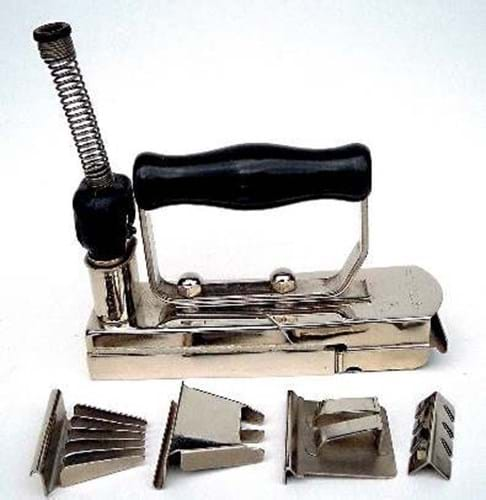
A pleating iron patented in 1928 by Hamilton and Sutton from Penny Savill's collection.. It is square nosed and has detachable plates that slide into the nose.
ATG: What is one of your most memorable purchases?
We were moving from Kyoto to Tokyo when we visited a local lea market. It was taking place in temple grounds – some people were arriving to pray, others hunting for bargains.
We wandered around and came to a long stall and there – right in the middle, in holy temple grounds – was a water iron that looked a bit like a kettle and resembled no other iron at all. Frantically I rushed to the end of the stall, across to the shelf and grabbed it before anyone else could take it. I love it!
ATG: A rule to live by?
Never give up looking – the hunt is as good as the find.
ATG: Who makes up the iron-collecting community?
Iron collectors are from all walks of life and all are represented in British Iron Collectors.
There is a strong international community and British collectors have close bonds with others from many European countries as well as the US, Australia and New Zealand.
ATG: How has the market changed since you’ve been collecting?
When I started out, irons that we considered collectable were plentiful and considered by many to be junk. Prices were low, irons readily
available and collections soon built up with good material.
Today fewer irons are appearing on the market unless a collector disposes of his/her collection and has a specialist auction.
There is almost no market at all for many irons. Only rare ones are really attracting any interest. Even then, the market is unpredictable, and prices fluctuate.
ATG: Where do you prefer to buy – shops, fairs or online?
We attend many of the large antique fairs, enjoy lea markets and car boot sales and I have bought at meetings of iron collectors.
Buying irons online is difficult because you really need to examine a piece and, of course, there are hefty postal charges for such heavy items.
Do you have a interesting collection you would like us to profile in ATG? Please contact us at editorial@antiquestradegazette.com


